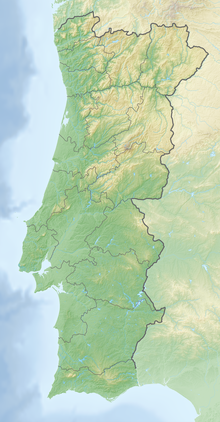Cividade de Bagunte
Location of the Cividade de Bagunte in Portugal. |
The Cividade de Bagunte is one of the largest Iron Age- Roman hill settlements of the Castro culture in northwestern Portugal .
location
The strongly fortified settlement is located on the top of the approximately 200 m high Monte da Soledade in the northeast of the district ( concelho ) Vila do Conde in the eponymous municipality ( freguesia ) Bagunte in the district of Porto .
Surrounded by a number of smaller, simultaneous settlements, the settlement dominates the landscape marked by the Ave and Este rivers .
history
Based on the finds, an almost 800-year-old settlement of the square from the 4th century BC to the 4th century AD can be made probable. A major redesign of the settlement took place in the Flavian period in the second half of the 1st century AD.
With an area of about 50 hectares, Bagunte is almost twice the size of the well-known settlements of Briteiros and Sanfins and, like other large settlements of this period, is surrounded by a number of smaller, simultaneous settlements.
The extent to which the settlement actually played a central role in the Iron Age cannot ultimately be derived with certainty from the purely archaeological findings.
research
The first reports mention the Castro as early as the Middle Ages, but more detailed descriptions of the settlement did not follow until 1899 by Martins Sarmento. The most important excavation campaigns were carried out in the years 1944–1947 by Fernando Russel Cortez. Regardless of the importance of the site, which was recognized early on, these were not continued in the following years or decades.
Intensive forest management and the use of the area for stone extraction caused lasting damage to the archaeological findings in the following decades. It was not until the mid-1990s that excavations and conservation measures were resumed, primarily in the area of the Acropolis; In addition, there are first attempts to open up this important settlement to the public.
The settlement area was registered and protected under the name Castro de Bagunte as early as 1910 as a Monumento Nacional; The extension of the protected area to 50 ha has currently been applied for.
Findings
In the course of the various excavations, the remains of around 800 pre-Roman and Roman buildings with the round and long-rectangular floor plans typical of the Castro culture were uncovered on a good 2 hectares. Some of the buildings had a semicircular vestibule, and paving of the floors could often be observed. However, due to the damage to the site, only part of the building has survived.
Currently, a distinction is made between the four areas A – D (Quarteirão / Bairro), which are separated from each other by paved streets. Within the individual areas, a distinction is made between up to five residential complexes (Núcleo) that were inhabited over a longer period of time. The allocation of floor plans, door openings and courtyards of the individual buildings within the residential complexes allows a relatively chronological construction sequence to be recognized, which shows the general change from round to rectangular floor plans.
The settlement was protected by three extensive wall rings with trenches in front of them.
Finds
A set of five silver torques stands out among the finds . One is made as a bracelet, the other four are made as a necklace. In addition to glass, glass beads, a ring, a knife and crucibles, numerous pre-Roman and Roman ceramics, including imports from other parts of the Roman Empire, were found.
In particular, the finds from excavations in the 1940s are kept in the Museu de Antropologia da Universidade do Porto .
literature
- Carlos A. Brochado de Almeida, Pedro Brochado de Almeida: Alguns apontamentos sobre a cividade de bagunte - Vila do conde. In: Portvgalia. Nova Série, Volume 36, 2015, pp. 49-62.
- Armando Coelho Ferreira da Silva: A Cultura Castreja no Norte de Portugal. In: Revista de Guimarães. Special volume 1, 1999, pp. 111-132.
- Thomas G. Schattner (Ed.): Archaeological guide through Portugal (= cultural history of the ancient world . Vol. 74). Philipp von Zabern, Mainz 1998, ISBN 3-8053-2313-1 , p. 70f.
- further reading under Patrimonio Cultural sv Bibliografia.
Individual evidence
- ↑ a b c d Carlos A. Brochado de Almeida, Pedro Brochado de Almeida: Alguns apontamentos sobre a cividade de bagunte - Vila do conde. In: Portvgalia. Nova Série, Volume 36, 2015, pp. 49-62.
- ^ Armando Coelho Ferreira da Silva: A Cultura Castreja no Norte de Portugal. In: Revista de Guimarães. Special volume 1, 1999, pp. 111-132, here p. 123.
- ↑ a b c DGPC | Pesquisa Geral. Retrieved October 31, 2017 (Portuguese).
- ^ Portal do Arqueólogo. Retrieved October 31, 2017 (Portuguese).
Web links
Coordinates: 41 ° 23 ′ 0.8 ″ N , 8 ° 39 ′ 20.3 ″ W.
